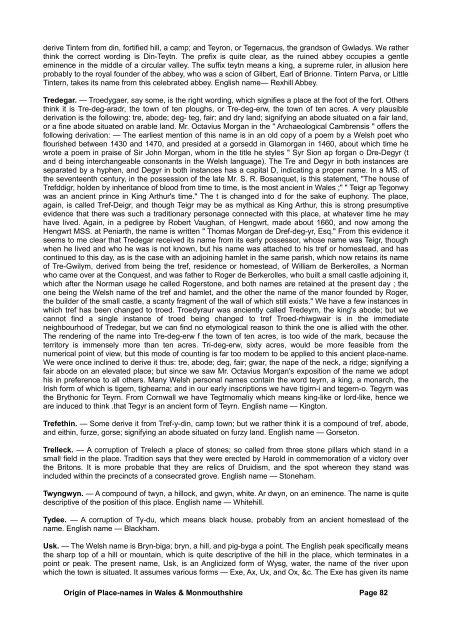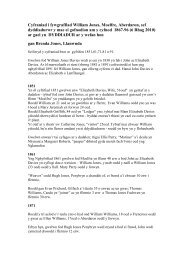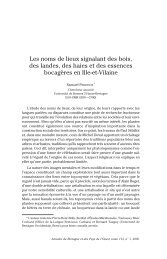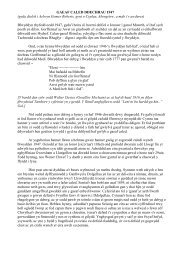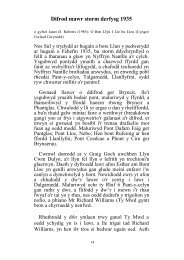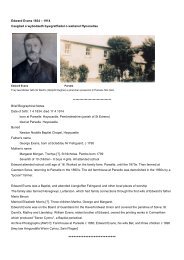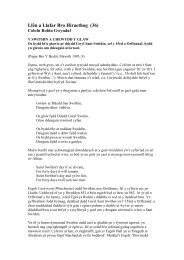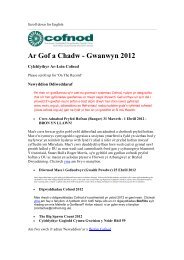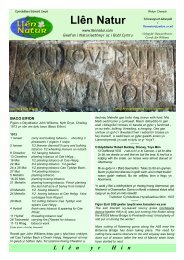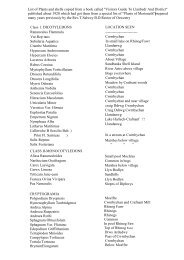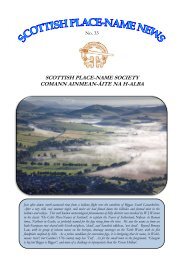handbook of the origin of place-names in wales and monmouthshire
handbook of the origin of place-names in wales and monmouthshire
handbook of the origin of place-names in wales and monmouthshire
- No tags were found...
Create successful ePaper yourself
Turn your PDF publications into a flip-book with our unique Google optimized e-Paper software.
derive T<strong>in</strong>tern from d<strong>in</strong>, fortified hill, a camp; <strong>and</strong> Teyron, or Tegernacus, <strong>the</strong> gr<strong>and</strong>son <strong>of</strong> Gwladys. We ra<strong>the</strong>rth<strong>in</strong>k <strong>the</strong> correct word<strong>in</strong>g is D<strong>in</strong>-Teytn. The prefix is quite clear, as <strong>the</strong> ru<strong>in</strong>ed abbey occupies a gentleem<strong>in</strong>ence <strong>in</strong> <strong>the</strong> middle <strong>of</strong> a circular valley. The suffix teytn means a k<strong>in</strong>g, a supreme ruler, <strong>in</strong> allusion hereprobably to <strong>the</strong> royal founder <strong>of</strong> <strong>the</strong> abbey, who was a scion <strong>of</strong> Gilbert, Earl <strong>of</strong> Brionne. T<strong>in</strong>tern Parva, or LittleT<strong>in</strong>tern, takes its name from this celebrated abbey. English name— Rexhill Abbey.Tredegar. — Troedygaer, say some, is <strong>the</strong> right word<strong>in</strong>g, which signifies a <strong>place</strong> at <strong>the</strong> foot <strong>of</strong> <strong>the</strong> fort. O<strong>the</strong>rsth<strong>in</strong>k it is Tre-deg-aradr, <strong>the</strong> town <strong>of</strong> ten ploughs, or Tre-deg-erw, <strong>the</strong> town <strong>of</strong> ten acres. A very plausiblederivation is <strong>the</strong> follow<strong>in</strong>g: tre, abode; deg- teg, fair; <strong>and</strong> dry l<strong>and</strong>; signify<strong>in</strong>g an abode situated on a fair l<strong>and</strong>,or a f<strong>in</strong>e abode situated on arable l<strong>and</strong>. Mr. Octavius Morgan <strong>in</strong> <strong>the</strong> " Archaeological Cambrensis " <strong>of</strong>fers <strong>the</strong>follow<strong>in</strong>g derivation: — The earliest mention <strong>of</strong> this name is <strong>in</strong> an old copy <strong>of</strong> a poem by a Welsh poet wh<strong>of</strong>lourished between 1430 <strong>and</strong> 1470, <strong>and</strong> presided at a gorsedd <strong>in</strong> Glamorgan <strong>in</strong> 1460, about which time hewrote a poem <strong>in</strong> praise <strong>of</strong> Sir John Morgan, whom <strong>in</strong> <strong>the</strong> title he styles " Syr Sion ap forgan o Dre-Degyr (t<strong>and</strong> d be<strong>in</strong>g <strong>in</strong>terchangeable consonants <strong>in</strong> <strong>the</strong> Welsh language). The Tre <strong>and</strong> Degyr <strong>in</strong> both <strong>in</strong>stances areseparated by a hyphen, <strong>and</strong> Degyr <strong>in</strong> both <strong>in</strong>stances has a capital D, <strong>in</strong>dicat<strong>in</strong>g a proper name. In a MS. <strong>of</strong><strong>the</strong> seventeenth century, <strong>in</strong> <strong>the</strong> possession <strong>of</strong> <strong>the</strong> late Mr. S. R. Bosanquet, is this statement, "The house <strong>of</strong>Trefddigr, holden by <strong>in</strong>heritance <strong>of</strong> blood from time to time, is <strong>the</strong> most ancient <strong>in</strong> Wales ;" " Teigr ap Tegonwywas an ancient pr<strong>in</strong>ce <strong>in</strong> K<strong>in</strong>g Arthur's time." The t is changed <strong>in</strong>to d for <strong>the</strong> sake <strong>of</strong> euphony. The <strong>place</strong>,aga<strong>in</strong>, is called Tref-Deigr, <strong>and</strong> though Teigr may be as mythical as K<strong>in</strong>g Arthur, this is strong presumptiveevidence that <strong>the</strong>re was such a traditionary personage connected with this <strong>place</strong>, at whatever time he mayhave lived. Aga<strong>in</strong>, <strong>in</strong> a pedigree by Robert Vaughan, <strong>of</strong> Hengwrt, made about 1660, <strong>and</strong> now among <strong>the</strong>Hengwrt MSS. at Peniarth, <strong>the</strong> name is written " Thomas Morgan de Dref-deg-yr, Esq." From this evidence itseems to me clear that Tredegar received its name from its early possessor, whose name was Teigr, thoughwhen he lived <strong>and</strong> who he was is not known, but his name was attached to his tref or homestead, <strong>and</strong> hascont<strong>in</strong>ued to this day, as is <strong>the</strong> case with an adjo<strong>in</strong><strong>in</strong>g hamlet <strong>in</strong> <strong>the</strong> same parish, which now reta<strong>in</strong>s its name<strong>of</strong> Tre-Gwilym, derived from be<strong>in</strong>g <strong>the</strong> tref, residence or homestead, <strong>of</strong> William de Berkerolles, a Normanwho came over at <strong>the</strong> Conquest, <strong>and</strong> was fa<strong>the</strong>r to Roger de Berkerolles, who built a small castle adjo<strong>in</strong><strong>in</strong>g it,which after <strong>the</strong> Norman usage he called Rogerstone, <strong>and</strong> both <strong>names</strong> are reta<strong>in</strong>ed at <strong>the</strong> present day ; <strong>the</strong>one be<strong>in</strong>g <strong>the</strong> Welsh name <strong>of</strong> <strong>the</strong> tref <strong>and</strong> hamlet, <strong>and</strong> <strong>the</strong> o<strong>the</strong>r <strong>the</strong> name <strong>of</strong> <strong>the</strong> manor founded by Roger,<strong>the</strong> builder <strong>of</strong> <strong>the</strong> small castle, a scanty fragment <strong>of</strong> <strong>the</strong> wall <strong>of</strong> which still exists." We have a few <strong>in</strong>stances <strong>in</strong>which tref has been changed to troed. Troedyraur was anciently called Tredeyrn, <strong>the</strong> k<strong>in</strong>g's abode; but wecannot f<strong>in</strong>d a s<strong>in</strong>gle <strong>in</strong>stance <strong>of</strong> troed be<strong>in</strong>g changed to tref Troed-rhiwgwair is <strong>in</strong> <strong>the</strong> immediateneighbourhood <strong>of</strong> Tredegar, but we can f<strong>in</strong>d no etymological reason to th<strong>in</strong>k <strong>the</strong> one is allied with <strong>the</strong> o<strong>the</strong>r.The render<strong>in</strong>g <strong>of</strong> <strong>the</strong> name <strong>in</strong>to Tre-deg-erw f <strong>the</strong> town <strong>of</strong> ten acres, is too wide <strong>of</strong> <strong>the</strong> mark, because <strong>the</strong>territory is immensely more than ten acres. Tri-deg-erw, sixty acres, would be more feasible from <strong>the</strong>numerical po<strong>in</strong>t <strong>of</strong> view, but this mode <strong>of</strong> count<strong>in</strong>g is far too modern to be applied to this ancient <strong>place</strong>-name.We were once <strong>in</strong>cl<strong>in</strong>ed to derive it thus: tre, abode; deg, fair; gwar, <strong>the</strong> nape <strong>of</strong> <strong>the</strong> neck, a ridge; signify<strong>in</strong>g afair abode on an elevated <strong>place</strong>; but s<strong>in</strong>ce we saw Mr. Octavius Morgan's exposition <strong>of</strong> <strong>the</strong> name we adopthis <strong>in</strong> preference to all o<strong>the</strong>rs. Many Welsh personal <strong>names</strong> conta<strong>in</strong> <strong>the</strong> word teyrn, a k<strong>in</strong>g, a monarch, <strong>the</strong>Irish form <strong>of</strong> which is tigern, tighearna; <strong>and</strong> <strong>in</strong> our early <strong>in</strong>scriptions we have tigirn-i <strong>and</strong> tegern-o. Tegyrn was<strong>the</strong> Brythonic for Teyrn. From Cornwall we have Tegtrnomaliy which means k<strong>in</strong>g-like or lord-like, hence weare <strong>in</strong>duced to th<strong>in</strong>k .that Tegyr is an ancient form <strong>of</strong> Teyrn. English name — K<strong>in</strong>gton.Trefeth<strong>in</strong>. — Some derive it from Tref-y-d<strong>in</strong>, camp town; but we ra<strong>the</strong>r th<strong>in</strong>k it is a compound <strong>of</strong> tref, abode,<strong>and</strong> eith<strong>in</strong>, furze, gorse; signify<strong>in</strong>g an abode situated on furzy l<strong>and</strong>. English name — Gorseton.Trelleck. — A corruption <strong>of</strong> Trelech a <strong>place</strong> <strong>of</strong> stones; so called from three stone pillars which st<strong>and</strong> <strong>in</strong> asmall field <strong>in</strong> <strong>the</strong> <strong>place</strong>. Tradition says that <strong>the</strong>y were erected by Harold <strong>in</strong> commemoration <strong>of</strong> a victory over<strong>the</strong> Britons. It is more probable that <strong>the</strong>y are relics <strong>of</strong> Druidism, <strong>and</strong> <strong>the</strong> spot whereon <strong>the</strong>y st<strong>and</strong> was<strong>in</strong>cluded with<strong>in</strong> <strong>the</strong> prec<strong>in</strong>cts <strong>of</strong> a consecrated grove. English name — Stoneham.Twyngwyn. — A compound <strong>of</strong> twyn, a hillock, <strong>and</strong> gwyn, white. Ar dwyn, on an em<strong>in</strong>ence. The name is quitedescriptive <strong>of</strong> <strong>the</strong> position <strong>of</strong> this <strong>place</strong>. English name — Whitehill.Tydee. — A corruption <strong>of</strong> Ty-du, which means black house, probably from an ancient homestead <strong>of</strong> <strong>the</strong>name. English name — Blackham.Usk. — The Welsh name is Bryn-biga; bryn, a hill, <strong>and</strong> pig-byga a po<strong>in</strong>t. The English peak specifically means<strong>the</strong> sharp top <strong>of</strong> a hill or mounta<strong>in</strong>, which is quite descriptive <strong>of</strong> <strong>the</strong> hill <strong>in</strong> <strong>the</strong> <strong>place</strong>, which term<strong>in</strong>ates <strong>in</strong> apo<strong>in</strong>t or peak. The present name, Usk, is an Anglicized form <strong>of</strong> Wysg, water, <strong>the</strong> name <strong>of</strong> <strong>the</strong> river uponwhich <strong>the</strong> town is situated. It assumes various forms — Exe, Ax, Ux, <strong>and</strong> Ox, &c. The Exe has given its nameOrig<strong>in</strong> <strong>of</strong> Place-<strong>names</strong> <strong>in</strong> Wales & Monmouthshire Page 82


